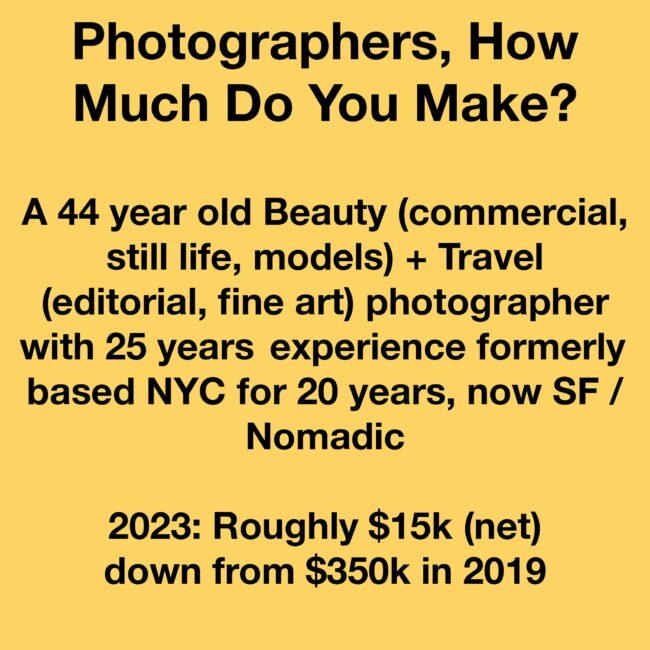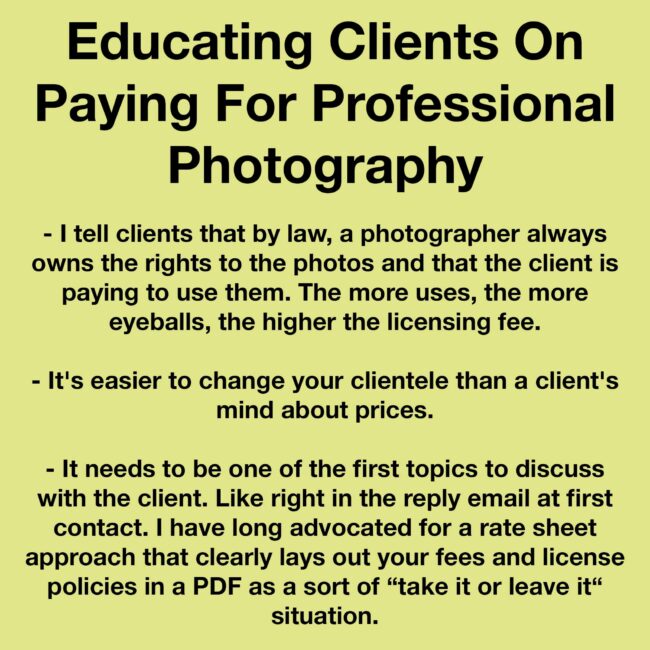
Most of my income was from the beauty industry in NY. Everything disappeared last year and I’m focusing on travel + travel writing now.
Up until last year: Commercial beauty 90%; Travel 10%. Clients included L’Oreal.
Now travel / editorial 100%. Clients are small editorial + gallery.
I have retirement savings and max out my SEP IRA each year.
Work days when I travel are vague because I’m not shooting every day.
I was bringing in $400k in the years right before Covid, but as of early last year, everything disappeared.
When I started shooting travel assignments, I began writing the stories as well. This really clicked for me creatively and the editors who knew me responded very well to it.
My previous beauty shoots: 1-2 days per month, 8-10 hours. Pre-covid $7k/day + roughly $10k retouching per shoot day. Licensing was all usage (digital, POS) except advertising.
Post covid, rates were slashed in half and the amount of work by a small fraction. Then everything disappeared.
Travel editorials: usually 1-2 weeks, $5K for images + story. 1-2 assignments per year.
Best recent shoots:
1. Retouching-only gig for Mac Cosmetics (APAC), about $10k for 10 images.
2. Travel Assignment in Bora Bora – $5k but everything was sponsored so zero expenses. I ended up getting 3 editorial stories + two fine art print sales ($4k) from that one trip.
Worst recent shoot:
God help me. It was an editorial cover story for The Explorers Club in NY. I did a trip to Vanuatu independently and the editor had seen some of the images and a story I wrote in another magazine and asked if I could do one for their magazine The Explorers Journal. It was of course for free but I thought it would be a great opportunity. I wrote a new story from scratch and gave her the best images. No response. I followed up again and again as she said it would be for the forthcoming issue. No response. After all that work I had done for free, she ghosted me. I was furious. She finally reappeared 6 months later and said it would be a cover story in the next issue and that she’d love to meet me and bring me to the club to get to know everyone. Great! She took the images and story, and never responded to a thing after that. Just appalling. I know I’m not alone in saying this but the level of ghosting and unresponsiveness in our industry has reached an unbelievable high.
I started learning video editing during covid and discovered I quite liked it. I’m just doing small projects with my iphone to practice and build a reel but maybe it’ll turn into something more.
I’ve tried everything for marketing from Agency Access (doesn’t work) to posting more on social media (doesn’t work) to networking events (doesn’t work). The only thing that has ever worked is pure word of mouth. When I let go of trying, things happen.
Best advice: when the creative director of Random House forced me against my will to write some travel blog posts for a Fodors rebrand. That turned into one of my biggest creative successes.
Worst advice: it’s ALWAYS something I never asked for and is always along the lines of “you just have to put yourself out there and demand to be seen”.
I share the frustration that ghosting and unresponsiveness has reached an all time high in this industry. My #1 client pre covid hadn’t paid me for 9 months yet I was still working nearly 7 days a week for them. The one in charge would post selfies all day long but “not have time” to deal with AP. I feel that the entire industry right now is a dumpster fire, everything is changing but no one knows what it’s changing into. The old trajectories don’t exist anymore and neither do the destinations. I feel like it’s time, at least for me personally, to take a step back and let the industry figure its shit out. We can blame it on social media, we can blame it on Gen Z’s taking the helm and not knowing how communication works, we can blame it on companies not willing to commit or invest in quality work, and we can blame it on magazines disappearing. But the unresponsiveness from people is what kills me. And I know I’m not alone.
